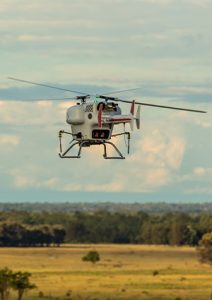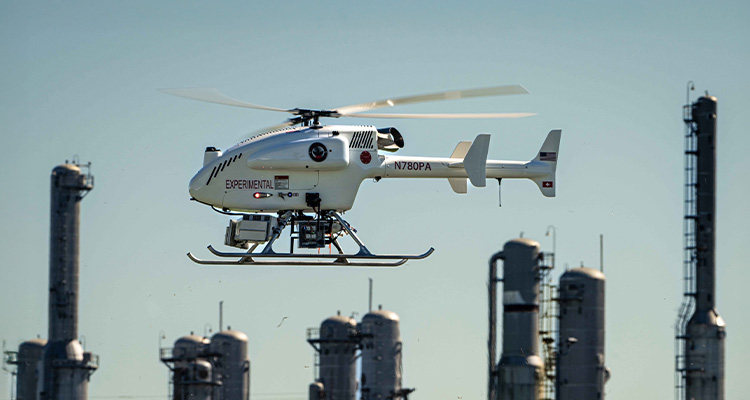Ulrich Amberg, CEO of SwissDrones, shares the safe and cost-effective solution afforded by long-range unmanned helicopter systems
My background is in engineering; I studied computer science and spent much of my career in professional services. I was a partner at KPMG for many years, working with large corporates around the world on transformational projects generally involving technology enablement. Alongside this, over the years, I also co-founded and invested in several technology startups, as well as sitting on the boards,” Ulrich Amberg, CEO of SwissDrones begins.
“About eight years ago, I decided to switch gears and move out of the consulting domain to dedicate my time and energy to these scale ups, and that decision led me to SwissDrones. I’ve been in my role as CEO for almost six years now and have reshaped our approach to implement a global scale-up strategy. My main priority is to look ahead and ensure we seize opportunities and progress with technologies and regulations; everything that goes hand in hand with building a disruptive solution in a growing industry. It’s an exciting time and has been a wild ride over the past few years.”

SwissDrones was founded in 2013 and is based out of Switzerland with its headquarters in Zurich and its manufacturing site in Buchs. The company is a leading manufacturer and operator of long-range uncrewed helicopter systems designed to replace manned helicopters for safe and cost-effective aerial intelligence gathering in surveillance, linear inspection and search and reconnaissance missions beyond visual line of sight (BVLOS). SwissDrones develops innovative systems and an intelligence-as-a-service solution that’s more sustainable and cost-effective, enabling organizations to reduce emissions and operational risks. Approved in over 35 countries, SwissDrones’ technology sets a new standard with unmatched flight endurance, heavy payload capacity, and real-time data insights for mission-critical operations.
The company has been named a Top 50 Global UAV Enterprise by the World UAV Federation and a Top 40 Civil Drone Platform Manufacturer by Drone Industry Insights. Today, SwissDrones’ aircraft have been deployed across six continents: Africa, Asia, Europe, North America, Oceania and South America.
“Currently, there is a gap between industry requirements and the existing way of working, which involves heavy, manned helicopters, inspecting infrastructure and providing aerial surveillance services. There have been several attempts to replace this process with simple, small drones, and many organizations operating in the energy industry have built their own programs but the general conclusion from these endeavors is that while it’s possible to carry out local inspections, there’s only so much a small drone can do.
“As such, to plug this gap, our solution offers an alternative to traditional manned helicopters. A solution that is safe, sustainable, and cost efficient, offering a significant reduction in risk, pollution, and cost when compared to manned missions. We replace manned helicopters with an uncrewed system, with long-range capability, that flies beyond the visual line of sight (BVLOS).”
BVLOS refers to drone operations where the pilot cannot see the drone with their naked eye, relying instead on sensors, cameras, and other technologies to maintain control and situational awareness. This contrasts with visual line of sight (VLOS) operations, where the pilot maintains direct visual contact with the drone. BVLOS operations are increasingly used for long-range or large-scale tasks like inspections, surveys, and deliveries, but they require more advanced technology and regulatory approvals due to the complexity. 
“We’re transforming the way all these missions are carried out, taking manned helicopters out of the process to disrupt the current application and replacing them with our uncrewed helicopters to capture data for real-time observation or to provide insights and actionable outcomes.”
Indeed, with SwissDrones’ SDO 50 model, missions are possible under difficult or dangerous circumstances, such as bad weather, darkness, or flying over hostile or otherwise unsafe areas, when manned operations are not feasible. The SDO 50 enables CO₂ emission reductions of up to 95 percent compared to manned helicopters. As such, long-range BVLOS drones can be a significant enabler for a greener future. Additionally, the vertical take-off and landing (VTOL) system is highly cost-effective compared to manned aerial solutions and requires less training to operate confidently.
Ongoing inspections of critical infrastructure such as high-voltage power lines, gas and oil pipelines and other far-stretched assets are critical for their uninterrupted operation and security. SwissDrones offers cost-effective unmanned solutions using market-leading cameras, sensors and software to address customer-specific needs for aerial data gathering and processing. Downtime is costly and manned inspection operations can often be dangerous to personnel. Unmanned aerial vehicles can access hard-to-reach places faster, cheaper and with less risk than manual inspections, and potentially allow the asset to remain online.
Indeed, leading energy provider, Southern Company, deploys SwissDrones’ SDO 50 flagship product to enhance aerial intelligence capabilities. “Energy companies are dealing with a host of difficult circumstances when it comes to maintaining their critical infrastructure,” says Ulrich. “From an increase in extreme weather events to cumbersome inspection practices, companies need new, innovative solutions. Teaming up with Southern Company will enable more efficient aerial surveillance and inspection to navigate those challenges.
“Southern Company decided to purchase our products and is now expanding its own capability to ramp up operations. The company has obtained its own approvals with the FAA based on the use and deployment of our aircraft.”
This collaboration signifies SwissDrones’ expansion into North America and reflects a broader industry trend toward adopting advanced uncrewed systems for critical infrastructure monitoring and emergency response.
While BVLOS drone operations are increasingly permitted, they do require specific authorization from aviation authorities. Drones flown out of sight of the operator are subject to stringent safety requirements, including robust risk assessments and advanced technologies such as detect and avoid (DAA) systems.
Aviation authorities around the world are currently working to address regulatory challenges that will enable authorized operators to operate BVLOS in a scaled, sustainable way. Safety is everyone’s priority; other airspace users need to be sufficiently protected, and the risk to people and property on the ground needs to be minimized.
“Being able to scale responsible drone use is essential for overcoming the technical limitations of manned flights,” Ulrich continues. “Manned flights, for example, can’t follow the exact same flight path as previously, which means it’s impossible to capture the exact same data set each time. That, in turn, makes it difficult to automate post-flight data evaluation for change analysis. The SDO 50 can be used for environmental monitoring applications including topography and vegetation mapping. In terms of pipeline inspections, this type of monitoring by high-end sensors can detect early signs of erosion.
“This technology enables users to build digital twins. It’s possible to create a 3D model of the whole corridor of a pipeline. For example, you can literally walk through hundreds of miles of pipeline and zoom into every detail to spot anomalies. Changes can be detected and reported without needing to physically send teams to inspect as operators already have the highest resolution digital representation of the environment.”
A light detection and ranging (LiDAR) system is a remote sensing technology that uses laser pulses to measure distances and generate accurate 3D models of terrain and infrastructure. Mounted on drones, a LiDAR system scans the ground using a rotating mirror that directs laser beams side-to-side. As the laser pulses hit objects, like vegetation, land, or pipelines, they bounce back to the sensor, creating millions of data points that are processed into detailed elevation maps.
In the oil and gas and utility sectors, LiDAR is a powerful tool for right-of-way (ROW) inspections along pipeline corridors. It helps detect encroachments, vegetation overgrowth, erosion, and structural changes critical for maintaining asset integrity and regulatory compliance. LiDAR also supports long-term monitoring, change detection, and planning by providing fast, high-resolution data over large, often remote, areas.
“From inspections and surveillance flights to safety patrols and cargo deliveries to remote places, I genuinely believe our solution can replace all these use cases. We’re already deploying drones to deliver urgently required spares to offshore rigs; these are the types of parts that have the potential to delay production and incur downtime. This is where the versatility of our solution comes into its own and these use cases can be met in parallel without the need for different types of drones.
“It is this type of capability that our customers are already telling us they need. This is the future. In fact, it’s already happening and we’re just waiting for the jigsaw puzzle of regulatory approval to be completed. It’s the operational complexity that takes time but we’re at the point where we’re accelerating real commercial contracts. We’re beyond merely carrying out pilot projects,” Ulrich concludes. “We have commercial contracts with some of the largest energy companies in the world and we believe in five or seven years there’ll be far fewer manned flights for these use cases.” ■
